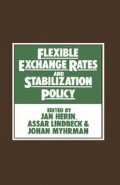Abstract
Under flexible exchange rates, world inflation is the weighted average of the national inflation rates. This paper is concerned with two categories of arguments which emphasize the higher probability of a higher inflation bias in a system of flexible exchange rates. The first category refers to a country’s lower inflationary discipline when it has adopted a floating exchange rate and the second category of arguments concerns either price rigidities which become virulent qua the system of flexible exchange rates or some automatic world price level increases following the introduction of floating exchange rates. The paper leads to the conclusion that flexible exchange rates are neither inherently more inflationary nor inherently less inflationary than fixed exchange rates.
Access this chapter
Tax calculation will be finalised at checkout
Purchases are for personal use only
Preview
Unable to display preview. Download preview PDF.
References
Claassen, E.-M.: Demand for international reserves and the optimum mix and speed of adjustment policies. American Economic Review, June 1975.
Claassen, E.-M.: The role of economic size in the determination and transmission of world inflation. In Inflation in Small Countries (ed. H. Frisch). Springer-Verlag (forthcoming in 1976).
Dornbusch, R.: Devaluation, money, and nontraded goods. American Economic Review, December 1973.
Dornbusch, R.: The theory of flexible exchange rate regimes and macroeconomic policy. Swedish Journal of Economics 78, No. 2, 1976.
Fried, J.: Inflation-unemployment trade-offs under fixed and floating exchange rates. Canadian Journal of Economics, February 1973.
Haberler, G.: Inflation as a worldwide phenomenon: An overview. Weltwirtschaftliches Archiv 110, No. 2, 1974.
Johnson, H.G.: Inflation, unemployment, and the floating rate. Canadian Public Policy, Spring, 1975.
Johnson, H.G.: Have floating rates worked so badly? Bulletin de l’Institut Economique de Paris, July-August, 1975.
Machlup, F.: Recent experiences with floating currencies. In Recent Issues in International Monetary Economics (ed. E.-M. Claassen & P. Salin). North-Holland, Amsterdam, 1976.
Melitz, J.: On the international transmission of inflation under floating exchange rates. Paper for the Konstanz Seminar on Monetary Theory and Monetary Policy, June 1975.
Wanniski, J.: The case for fixed exchange rates. Wall Street Journal, June 14, 1974.
Author information
Authors and Affiliations
Editor information
Editors and Affiliations
Copyright information
© 1977 The Scandinavian Journal of Economics
About this chapter
Cite this chapter
Claassen, EM. (1977). World Inflation Under Flexible Exchange Rates. In: Herin, J., Lindbeck, A., Myhrman, J. (eds) Flexible Exchange Rates and Stabilization Policy. Palgrave Macmillan, London. https://doi.org/10.1007/978-1-349-03359-1_19
Download citation
DOI: https://doi.org/10.1007/978-1-349-03359-1_19
Publisher Name: Palgrave Macmillan, London
Print ISBN: 978-1-349-03361-4
Online ISBN: 978-1-349-03359-1
eBook Packages: Palgrave Economics & Finance CollectionEconomics and Finance (R0)

